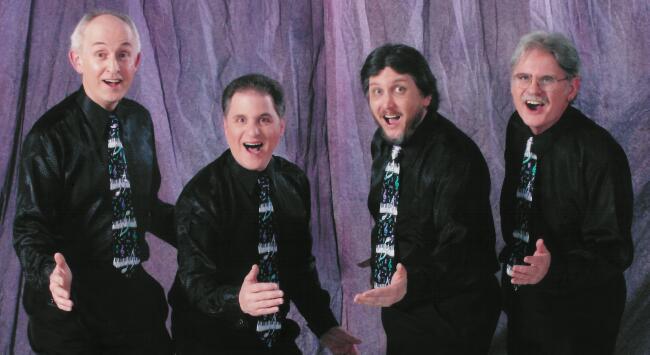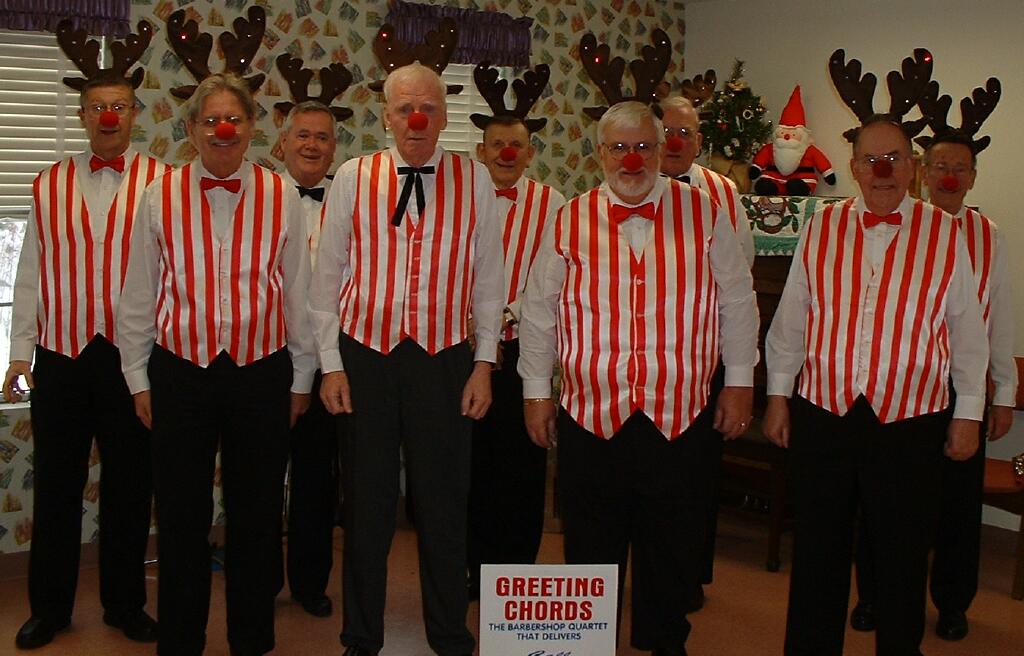 It's great to be a barbershopper!
It's great to be a barbershopper!

Barbershop chorus and quartet singing is one of the loves of my life. I love to sing harmony. Lots of harmony, and I almost always sing tenor. For me, singing is what it's all about. Singing helps you forget your daily cares and hassles for a little while. And great barbershop harmony is especially conducive to getting one in a good mood or frame of mind.
I currently sing with the Denver Sound of the Rockies, and most recently was joining the Northbrook New Tradition before moving to the Denver area. Before that I sang with the Portland Metro Bridge Town Sound and the Salem Senate-Aires, an awesome quartet Kinetics, and previously sang with the Heart of Texas chorus, the Syracuse New Spirit Of Harmony, the Buffalo Queen City Chordsmen, and the Gowanda Kings of Persia.
 Kinetics
Kinetics
Paul Lewis, Baritone
Tom Giering, Bass
Jeff Buckles, Tenor
Me, Tenor
 Besides, it is a lot of fun, especially when there is some serious silliness
included.
Besides, it is a lot of fun, especially when there is some serious silliness
included.
The Greeting Chords, Larry Brennan, Director
New Spirit of Harmony Chorus
Fayetteville, NY
They graciously invited me to sing with them when I spent a month in the
Syracuse area in November and December of 2002.
Singers are just nice people. Barbershoppers form a large group with diverse interests in all age ranges, all there for the feeling of fellowship and camaraderie that singing Barbershop tends to engender.
Why sing?
I wish to see all arts, principally music, in the service of Him who gave and created them. Music is a fair and glorious gift of God. I would not for the world forego my humble share of music. Singers are never sorrowful, but are merry and smile through their troubles in song. Music makes people kinder, gentler, more staid and reasonable. I am strongly persuaded that after theology there is no art that can be placed on a level with music; for besides theology, music is the only art capable of affording peace and joy of the heart... the devil flees before the sound of music almost as much as before the word of God. — Martin Luther
What Is Barbershop Harmony?
Barbershop harmony is a style of unaccompanied singing in which three voices harmonize to a melody. Each quartet or chorus is made up of four voice parts called tenor, lead, baritone and bass. While the lead usually sings the melody line, the tenor (counter-tenor voice) harmonizes above the melody. The bass sings the lowest harmonizing notes, and the baritone provides in-between notes, either above or below the lead, completing the chords that give barbershop singing its distinctive four-part sound.
The style is further identified by the use of chords that are pleasing or harmonious. Tuning is as nearly perfect as is vocally possible. The style is distinguished by uniformity of word sounds and a special emphasis on close harmony.
A few important characteristics...
- The Barbershop 7th gives a distinctive richness to the musical sound. The music is characterized by consonant four-part chords for every melody note, featuring major and minor chords with the barbershop (dominant-type) seventh chords resolving primarily on the circle of fifths. Sixth, ninth and major seventh chords are avoided except where demanded by the melody, while minor second interval chords are not used.
- A distinctive element of barbershop harmony is the phenomenon of expanded sound, called ringing a chord. Singers create this thrilling musical effect when the four voices reinforce each other to produce audible overtones — a sort of 'fifth voice'.
- Every barbershop song ends with a Tag. The tag (or coda) is the end section of a song — the final 6-8 measures. Tag singing in itself is a favorite pastime with many barbershop singers.
- The visual presentation of barbershop singing is very important, therefore appropriate Choreography helps to convey the theme and character of a song.
It is a combination of these special characteristics and others which make barbershop singing such a captivating and emotional entertainment. Many songs that lend themselves particularly well to barbershop harmonization are those from the heyday of Tin Pan Alley, from about 1890 to 1920. Songs of that era were written with home sheet music sales in mind, and consequently were written to be singable by people with average vocal ranges, skills and interests. Lyrics celebrating simple, heartfelt emotions are characteristic of songs in the barbershop style, which is why we hear so many songs about young love, Mother, and nostalgia for days gone by.
The Barbershop Pole
In a bygone era barbers, or rather barber surgeons, cut hair and performed dental surgery and bloodletting. The bloodied bandages from bloodletting operations entwined on a staff became the symbol red and white barber pole for the barber profession. In time, barbershop singers began to use the barber pole logo which identified the music's place of origin.
Was barbershop harmony actually sung in barbershops?
Certainly — and on street corners (it was sometimes called curbstone harmony) and at social functions and in parlors. Its roots are not just the white, Middle America of Norman Rockwell's famous painting. Rather, barbershop is a melting pot product of African American musical devices, European hymn singing culture, and an American tradition of recreational music — a tradition SPEBSQSA continues today.
Immigrants to the new world brought with them a musical repertoire that included hymns, psalms, and folk songs. These simple songs were often sung in four parts with the melody set in the male tenor, the second lowest voice, and the women singing harmony above.
Minstrel shows of the mid-1800s often consisted of the white singers in black face (later black singers themselves) performing songs and sketches based on a romanticized vision of plantation life. As the minstrel show was supplanted by the equally popular vaudeville, the tradition of close harmony quartets remained, often as a four act combining music with ethnic comedy that would be scandalous by modern standards.
The barbershop style of music is first associated with black southern quartets of the 1870s, such as The American Four and The Hamtown Students. The African influence is particularly notable in the improvisational nature of the harmonization, and the flexing of melody to produce harmonies in swipes and snakes. Black quartets, cracking a chord were commonplace at places like Joe Sarpy's Cut Rate Shaving Parlor in St. Louis, or in Jacksonville, Florida, where, black historian James Weldon Johnson writes, "every barbershop seemed to have its own quartet."
The first written use of the word barbershop when referring to harmonizing came in 1910, with the publication of the song, "Play That Barbershop Chord" — evidence that the term was in common parlance by that time.
In the early 1900s, though, pop music success depended on sales of sheet music to the general public. The song writers made their living by appealing to the needs and tastes of the recreational musician. To become a sheet music hit, songs had to be easily singable by average singers, with a average vocal ranges and average control. This called for songs with simple, straightforward melodies, and heartfelt, commonplace themes and images. Music published in that era often included an instrumental arrangement for piano or ukulele, and also a vocal arrangement for male quartet.
The phonograph made it possible to actually hear the new songs of that time. Professional quartets recorded hundreds of songs for the Victor, Edison, and Columbia labels, which spurred sheet music sales. For example, "You're The Flower Of My Heart, Sweet Adeline" captured the hearts of harmony lovers, not simply because it easily adapted to harmony, but also because it was heavily promoted by the popular Quaker City Four and other quartets.
What Is S.P.E.B.S.Q.S.A.? B.H.S.?
Post World War I and the influence of radio in disseminating the popularity of new and other musical styles brought about a wane in barbershop music. Then in 1938 there was a rebirth when S.P.E.B.S.Q.S.A. (Society for the Preservation and Encouragement of Barber Shop Quartet Singing in America) was formed to preserve that music known as Barbershop Harmony. For reasons not entriely supported by all barbershoppers, the name was recently modernized to B.H.S. (Barbershop Harmony Society).
To find some really great information about barbershopping, or to find out how to find barbershoppers in your area, you can find it on the BHS / SPEBSQSA web site.

